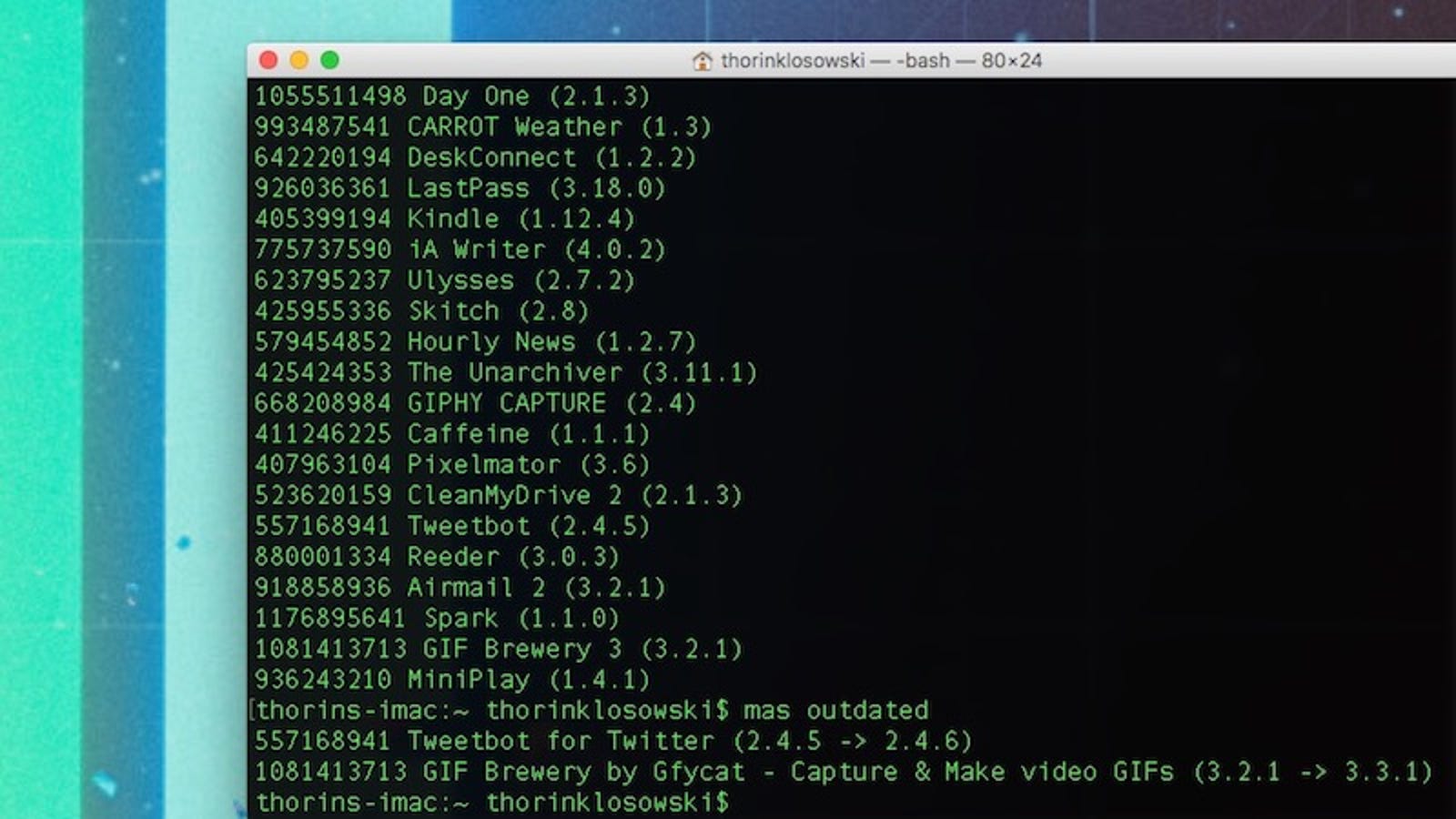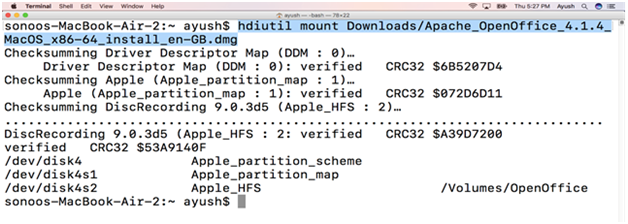Mac Os Terminal Mount Dmg Command Line

- Mac Dmg Os
- Mac Os X Dmg Torrent
- Mac Os Terminal Mount Dmg Command Line System
- Mac Os Terminal Mount Dmg Command Line 5
Double click the DMG so it mounts. Open Disk Utility (Utilities Disk Utility). Right click the DMG Mount and select the “Convert” option. Disk Utility – Right click mounted GMD image and choose Convert. In the dialog that now opens, set the “Image Format” to “DVD/CD master” and click “Save“.
Oct 13, 2019 今天和大家分享最新的 Logic Pro X for Mac 10.4.7 版本,兼容最新的 macOS Catalina 10.15 系统,性能提升以及轨道数和通道数增加,这是苹果官方出品的强大专业的音乐制作编辑工具,Logic Pro X 为音乐人提供了从创作第一个音符到完成最后的母带所需的一切. Logic Pro X 10.4.0 Logic Pro 是一款Mac平台的數字音頻工作站於MIDI音序器軟體、音樂合成,提供軟件樂器,音頻效果和錄音設備。它還支持Apple Loops - 免版稅,專業記錄的樂器循環。. Logic pro x 10.4.7 dmg 破解 2.
| Click here to return to the 'Mount .DMG images remotely via the Terminal' hint |
from the manpage for hdid:
With OS X version 10.3, hdid calls the DiskImages.framework and its helpers take care of any out-of-kernel image serving duties. Thus hdid exists primarily for backwards compatibility. Generally, hdiutil attach should be favored over hdid.
so the correct command is hdiutil attach URL. works fine for me.
This works fine on Tiger apart from one thing..
How do you mount an encrypted image remotely?
When I try to do this locally, it pops up a window on the desktop asking for the password.
When I attempt from a remote ssh session, I get the error:
hdid: attach canceled
hdiutil: attach failed - Network is unreachable
Thanks

Mac Dmg Os
In earlier versions of Mac OS X (10.2?) you could simply
% open disk://host.tld/image.dmg
but doesn't work anymore, Any ideas why?
---
http://www.google.com/search?as_q=%22Authored+by%3A+david-bo%22&num=10&hl=en&ie=ISO-8859-1&btnG=
Mac Os X Dmg Torrent
Is that the URL protocol? disk:// ? I've never heard of that one.
I just did an 'open disk.dmg' while ssh'd into a system which I was also logged into and it worked, but it opened up the GUI app on the remote system to mount the image. When I logged out and tried again I got an error about not being able to connect to the windowserver. These were just local dmg files, but I the premise is the same.
- http://www.euronet.nl/~tekelenb/playground/security/URLschemes/archive.html
Mac Os Terminal Mount Dmg Command Line System
Here is a writeup I did last year on how to download disk images, mount them, and install software from the command line. Very useful when you admin a machine only via SSH.
$ cat HeadlessInstall.txt
10 August 2004 Brett Johnson
This describes some of the steps necessary to perform the
installation of Mac OS X packages via the command line.
1) Download the Package
Download the installation image to a local directory.
I usually download packages to the ~admin/staging directory [a client convention].
Don't try to download it to some target directory like /etc or /usr
I use 'curl' to fetch the package from the net. I usually Ctrl-click
or right-click the package link in Safari (running locally) and select
'Copy link to Clipboard'. This copies the URL to the package to the
clipboard. I then paste the URL into the curl command in a ssh login
window to this server. Note that curl writes its output to stdout,
so be sure to redirect it to a file. For example
% curl http://www2.entropy.ch/download/Entropy-PHP-4.3.6-4.dmg > Entropy-PHP-4.3.6-4.dmg
This DOESN'T work for things on SourceForge, where the links are actually
javascript that goes to a mirror. In that case, download it locally,
then use sftp (or Fugu) to move it to this server.
2) If it is a compressed archive, decompress it using the appropriate tool.
For instance suppose you have a .tar.gz file:
% ls
xyzzy.pkg.tar.gz
% gunzip xyzzy.pkg.tar.gz
% tar -xvf xyzzy.pkg.tar
3) If it is a disk image file (.dmg) mount it using hdid. By default,
the disk images are mounted under the /Volumes directory. I see no
reason to do otherwise.
% hdid Entropy-PHP-4.3.6-4.dmg
% ls /Volumes
Backup HD Entropy PHP 4.3.6-4 Server HD
% cd '/Volumes/Entropy PHP 4.3.6-4'
% ls
Documentation.html php-4.3.6.pkg
4) Run the command line version of the Mac OS X installer. By default
the installer produces terse output suitable for parsing by scripts
doing installations. We will make the output verbose [human readable].
The installer takes the package name as well as the target Volume.
The installer is /usr/sbin/installer , which should be on the path.
The installer must be run as root, so be prepared to sudo..
% sudo /usr/sbin/installer -verbose -pkg php-4.3.6.pkg -target /
5) Don't forget to unmount the .dmg disk image if you mounted one.
Here we execute the 'mount' command to determine which virtual
disk device our dmg is mounted as (in this case it is /dev/disk2s2).
Then we use 'hdiutil detach' to unmount it.
% mount
/dev/disk0s3 on / (local, journaled)
/dev/disk1s3 on /Volumes/Backup HD (local)
automount -nsl [336] on /Network (automounted)
/dev/disk2s2 on /Volumes/Entropy PHP 4.3.6-4 (local, nodev, nosuid, read-only, mounted by admin)
% hdiutil detach /dev/disk2s2 -force
'disk2' unmounted.
'disk2' ejected.
Mac Os Terminal Mount Dmg Command Line 5
Here is a writeup I did last year on how to download disk images, mount them, and install software from the command line. Very useful when you admin a machine only via SSH.
$ cat HeadlessInstall.txt
10 August 2004 Brett Johnson
This describes some of the steps necessary to perform the
installation of Mac OS X packages via the command line.
1) Download the Package
Download the installation image to a local directory.
I usually download packages to the ~admin/staging directory [a client convention].
Don't try to download it to some target directory like /etc or /usr
I use 'curl' to fetch the package from the net. I usually Ctrl-click
or right-click the package link in Safari (running locally) and select
'Copy link to Clipboard'. This copies the URL to the package to the
clipboard. I then paste the URL into the curl command in a ssh login
window to this server. Note that curl writes its output to stdout,
so be sure to redirect it to a file. Install silverlight.dmg on android. For example
% curl http://www2.entropy.ch/download/Entropy-PHP-4.3.6-4.dmg > Entropy-PHP-4.3.6-4.dmg
This DOESN'T work for things on SourceForge, where the links are actually
javascript that goes to a mirror. In that case, download it locally,
then use sftp (or Fugu) to move it to this server.
2) If it is a compressed archive, decompress it using the appropriate tool.
For instance suppose you have a .tar.gz file:
% ls
xyzzy.pkg.tar.gz
% gunzip xyzzy.pkg.tar.gz
% tar -xvf xyzzy.pkg.tar
3) If it is a disk image file (.dmg) mount it using hdid. By default,
the disk images are mounted under the /Volumes directory. I see no
reason to do otherwise.
% hdid Entropy-PHP-4.3.6-4.dmg
% ls /Volumes
Backup HD Entropy PHP 4.3.6-4 Server HD
% cd '/Volumes/Entropy PHP 4.3.6-4'
% ls
Documentation.html php-4.3.6.pkg
4) Run the command line version of the Mac OS X installer. By default
the installer produces terse output suitable for parsing by scripts
doing installations. We will make the output verbose [human readable].
The installer takes the package name as well as the target Volume.
The installer is /usr/sbin/installer , which should be on the path.
The installer must be run as root, so be prepared to sudo..
% sudo /usr/sbin/installer -verbose -pkg php-4.3.6.pkg -target /
5) Don't forget to unmount the .dmg disk image if you mounted one.
Here we execute the 'mount' command to determine which virtual
disk device our dmg is mounted as (in this case it is /dev/disk2s2).
Then we use 'hdiutil detach' to unmount it.
% mount
/dev/disk0s3 on / (local, journaled)
/dev/disk1s3 on /Volumes/Backup HD (local)
automount -nsl [336] on /Network (automounted)
/dev/disk2s2 on /Volumes/Entropy PHP 4.3.6-4 (local, nodev, nosuid, read-only, mounted by admin)
% hdiutil detach /dev/disk2s2 -force
'disk2' unmounted.
'disk2' ejected.